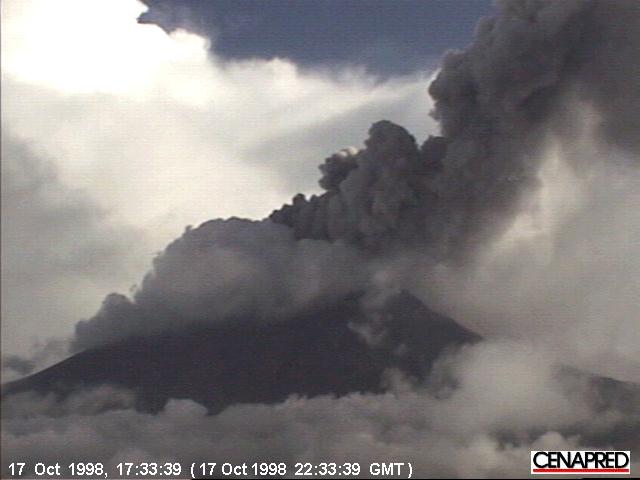Report on Popocatepetl (Mexico) — October 1998
Bulletin of the Global Volcanism Network, vol. 23, no. 10 (October 1998)
Managing Editor: Richard Wunderman.
Popocatepetl (Mexico) Moderate eruptions, 17 October ashfall in Mexico City
Please cite this report as:
Global Volcanism Program, 1998. Report on Popocatepetl (Mexico) (Wunderman, R., ed.). Bulletin of the Global Volcanism Network, 23:10. Smithsonian Institution. https://doi.org/10.5479/si.GVP.BGVN199810-341090
Popocatepetl
Mexico
19.023°N, 98.622°W; summit elev. 5393 m
All times are local (unless otherwise noted)
There were a few instances of moderate disturbance during October, and a relatively large emission occurred on 17 October; otherwise, Popocatépetl remained generally stable at low levels of eruptive activity, including almost daily emissions of steam and gas. Since the possibility of explosions remained, authorities recommended that no one approach within 4 km of the crater. The caution light remained "yellow" throughout the month.
Steam-and-gas fumaroles rose up to 500 m above the summit several times during the first week of October. The emissions usually blew SE. Two slightly larger exhalations lasting 5 minutes each at 0218 and 1409 on 4 October may have also released ash, but this was unconfirmed owing to bad weather obstructing views of the volcano. At 2312 on 5 October an explosive event began. An intense two minute phase was followed by 30 minutes of steam, gas, and ash emission that formed a plume 4 km above the crater. Glow was also seen at this time. Activity quickly diminished to previous low levels.
At 1715 on 17 October a larger exhalation began: its intense phase lasted about 16 minutes and produced an ash column (figure 27). The plume rose 2 km above the summit and blew NW (towards Mexico City).
 |
Figure 27. Basal portion of an ash column from Popocatepetl on the afternoon of 17 October as seen from a video monitor. Courtesy of CENAPRED. |
The ash column was initially detected by Doppler radar located at CENAPRED headquarters in Mexico City, and staff there immediately informed air-traffic controllers. The ash emission persisted for 20 minutes, after which the volcano returned to its previous low-level activity (steam and gas emissions only). One hour after the beginning of the event, reports were received of ashfall at Amecameca, Tenango del Aire, and other towns NW of the volcano.
At 2040 another smaller exhalation took place with a duration of only 1 minute. At about 2100 light ash from the earlier eruption fell at CENAPRED headquarters, UNAM, and at other places in SW Mexico City. Activity soon dropped to characteristic low-intensity exhalations. A similar moderate emission lasted 1 minute at 1859 on 24 October; the event was followed by low-amplitude, high-frequency tremor for about 20 minutes, producing a 2,500-m-high column of gas, water vapor, and ash.
A-type earthquakes were recorded at 0956 on 16 October (M 2.6, at a point 6.6 km below the summit), at 2227 on 22 October (M 2.0, at a point 7 km below the crater), at 1751 (M 2.1) and 1919 (M 1.8) on 29 October, and at 0942 (M 2.4) on 30 October. Two minutes of low-amplitude, low-frequency tremor began at 1355 on 29 October. None of these events seemed to affect activity at the volcano.
Geological Summary. Volcán Popocatépetl, whose name is the Aztec word for smoking mountain, rises 70 km SE of Mexico City to form North America's 2nd-highest volcano. The glacier-clad stratovolcano contains a steep-walled, 400 x 600 m wide crater. The generally symmetrical volcano is modified by the sharp-peaked Ventorrillo on the NW, a remnant of an earlier volcano. At least three previous major cones were destroyed by gravitational failure during the Pleistocene, producing massive debris-avalanche deposits covering broad areas to the south. The modern volcano was constructed south of the late-Pleistocene to Holocene El Fraile cone. Three major Plinian eruptions, the most recent of which took place about 800 CE, have occurred since the mid-Holocene, accompanied by pyroclastic flows and voluminous lahars that swept basins below the volcano. Frequent historical eruptions, first recorded in Aztec codices, have occurred since Pre-Columbian time.
Information Contacts: Servando De la Cruz-Reyna1,2, Roberto Quaas1,2, Carlos Valdés G.2, and Alicia Martinez Bringas1. 1Centro Nacional de Prevencion de Desastres (CENAPRED) Delfin Madrigal 665, Col. Pedregal de Santo Domingo,Coyoacan, 04360, México D.F. (URL: https://www.gob.mx/cenapred/); 2Instituto de Geofisica, UNAM, Coyoacán 04510, México D.F., México.

